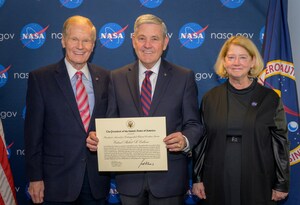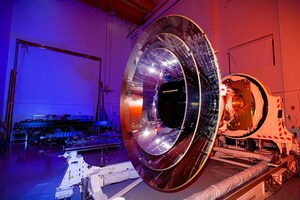WASHINGTON, March 24, 2016 /PRNewswire-USNewswire/ -- Media are invited to see a NASA spacecraft that is safer on the ground and more efficient in space during a tour March 31 at Ball Aerospace & Technologies Corp. in Boulder, Colorado, showcasing NASA's Green Propulsion Infusion Mission (GPIM).
Media are asked to arrive by 10:15 a.m. MDT for badging at the Ball Fisher Building, located at 1600 Commerce St. in Boulder. Remarks will begin at 10:30 a.m., followed at 11 a.m. by a tour of Ball facilities and GPIM spacecraft viewing. NASA and industry officials will be available for questions and one-on-one interviews from 11:45 a.m. to 12:15 p.m.
Speakers include:
- Steve Jurczyk, associate administrator for NASA's Space Technology Mission Directorate in Washington
- Rob Strain, president of Ball Aerospace & Technologies Corp.
- Chris McLean, principal investigator for GPIM at Ball Aerospace & Technologies Corp.
- Julie Van Kleeck, vice president of Space Programs at Aerojet Rocketdyne
- U.S. Rep. Ed Perlmutter of Colorado
Media interested in participating must contact Gina Anderson at [email protected] Roz Brown at [email protected] 5 p.m. March 29.
GPIM recently passed a major flight readiness milestone with the successful completion of functional and environmental testing of its systems and software. The spacecraft is scheduled for launch in early 2017 and will demonstrate the practical capabilities of a hydroxyl ammonium nitrate based fuel/oxidizer propellant blend, known as AF-M315E, developed by the U.S. Air Force Research Laboratory at Edwards Air Force Base in California. The new propellant offers higher performance and is safer to handle and easier on the environment than traditional chemical fuels such as hydrazine currently used in spacecraft thrusters. It also requires fewer handling restrictions and has potentially shorter launch processing times, resulting in lowered costs.
More of the new propellant can be stored in propellant tanks of the same volume, resulting in a 50-percent increase in spacecraft maneuvering capability for a given volume. It also has a lower freezing point than hydrazine, requiring less spacecraft power to maintain the propellant temperature. These characteristics make it ideal for a wide range of emerging small, deep space satellite missions.
The GPIM Mission is managed by the Technology Demonstration Missions program office at NASA's Marshall Space Flight Center in Huntsville, Alabama, and funded by NASA's Space Technology Mission Directorate.
For more information about the NASA's Green Propellant Infusion Mission, visit:
http://www.nasa.gov/mission_pages/tdm/green/overview.html
Logo - http://photos.prnewswire.com/prnh/20081007/38461LOGO
SOURCE NASA
Related Links
WANT YOUR COMPANY'S NEWS FEATURED ON PRNEWSWIRE.COM?
Newsrooms &
Influencers
Digital Media
Outlets
Journalists
Opted In




Share this article